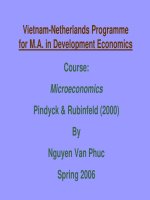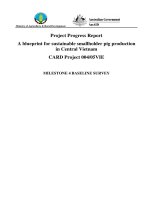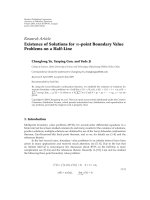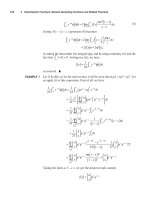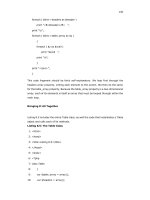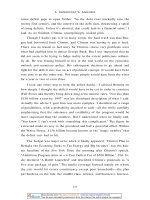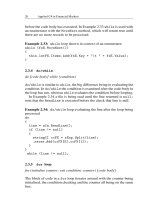valuation for m a Building Value in private companies phần 4 docx
Bạn đang xem bản rút gọn của tài liệu. Xem và tải ngay bản đầy đủ của tài liệu tại đây (110.88 KB, 31 trang )
80 Measuring Synergies
The value of a target, however, cannot be enhanced by at-
tributing to it a lower cost of capital through use of more debt fi-
nancing. Since any acquirer could achieve this benefit, such finan-
cial manipulations seldom have genuine value-creating potential.
The combined entity also may create certain tax benefits, such
as use of net operating loss carryovers or the ability to incorporate
in a jurisdiction that provides favorable tax rates. Acquirers are cau-
tioned, however, to recognize that most financial economies can-
not materially improve a company’s strategic position and seldom
should be the driving force behind a transaction.
KEY VARIABLES IN ASSESSING SYNERGIES
In assessing the potential savings from each of these synergy
sources, members of an M&A team should focus relentlessly on
three variables that can dramatically influence the accuracy of the
estimated synergy and value calculation.
1. Size of synergy benefit. The synergy value should be quantified
in a forecast of net cash flows that includes estimates of
revenues, expenses, financing and tax costs, and
investments in working capital and fixed assets. Each
component of the forecast, particularly all estimated
improvements, must be challenged rigorously. Acquisition
team members must resist the natural inclination to buy
into the deal emotionally, which so often leads to overly
optimistic revenue and expense estimates. Each element in
the forecast must be estimated accurately.
2. Likelihood of achievement. The business combination will
project various benefits, some of which have a very high
likelihood of success while others may be long shots. For
example, the likelihood that the administrative costs
associated with the target’s board of directors can be
eliminated is about 100%. Conversely, achieving certain
sales goals against stiff competition is probably far less
definite. These differences must be noted and allowed for
in the forecast. Computing the probability of various
outcomes, such as optimistic, expected, and pessimistic, or
Synergy and Advanced Planning 81
through a Monte Carlo simulation, helps to quantify the
range of possible outcomes. In particular, management
should be sensitive to downside projections and their
consequences.
3. Timing of benefits. The buyer’s M&A team must recognize
that while the acquisition usually occurs as a single
transaction, its benefits accrue over the forecast period that
may cover many years. The value of the acquisition and its
success are critically tied to achieving the improved cash
flows according to the forecasted time schedule. Any delays
push cash flows farther into the future and reduce their
present value. Temptations to accelerate the timing of
revenue enhancements or cost savings must be avoided,
with the timing of each assumption challenged just as the
amounts are. The history of M&A is littered with stories of
how unrealistic acceleration of improvements to enhance
the attractiveness of an acquisition led to overestimation of
synergy value. The M&A team that succumbs to this
pressure is first and foremost fooling itself.
The clear point here is to stress the importance of objectivity
and rigorous due diligence in the examination of forecasted syn-
ergies. Investors anticipate improvements in the performance of
both the acquirer and the target in the values they establish for
each company as stand-alone entities. The synergies related to the
acquisition must reflect improvements beyond those already antic-
ipated. The value of these synergies must exceed the premium over
the acquirer’s fair market value in order to create value. Thus, every
forecasted synergy must be challenged aggressively in terms of the
estimated amount, the likelihood of achievement, and when that
benefit will occur. Companies that overlook this process are invit-
ing unpleasant surprises and disappointment in the future.
SYNERGY AND ADVANCED PLANNING
The acquisition planning process described in Chapter 4 empha-
sized the need to tie the acquisition plan to the company’s over-
all strategic plan. Within this context, each acquisition should be
82 Measuring Synergies
evaluated in light of the likelihood of achieving the forecasted
synergies. Mark L. Sirower describes the “Cornerstones of Syn-
ergy” as four elements of an acquisition strategy that must be in
place to achieve success with synergies. As shown in Exhibit 5-1,
lack of any of the four dooms the project, according to Sirower.
Sirower’s cornerstones include:
• Strategic vision. Represents the goal of the combination,
which should be a continuous guide to the operating plan
of the acquisition.
• Operating strategy. Represents the specific operational steps
required to achieve strategic advantages in the combined
entity over competitors.
• Systems integration. Focuses on the implementation of the
acquisition while maintaining preexisting performance
targets. For success, these should be planned in considerable
detail in advance of the acquisition to achieve the timing of
synergy improvements.
• Power and culture. With corporate culture changing with the
acquisition, the decision-making structure in the combined
entity, including procedures for cooperation and conflict
Exhibit 5-1 Sirower’s Cornerstones of Synergy
Strategic
Vision
Operating
Strategy
Power &
Culture
Systems
Integration
Premium
Competitor ReactionsCompetitor Reactions
Competitor Reactions
Source: Mark L. Sirower, The Synergy Trap: How Companies Lose the Acquisition Game (New
York: The Free Press, 1997, 2000), p. 29.
Synergy and Advanced Planning 83
resolution, must be determined and implemented. Success
in the integration requires effectiveness throughout the
newly combined organization which forces the need for
clarity of purpose.
Synergy has acquired almost a mythical reputation in M&A
for the rewards that it reputedly provides. Watch out for these re-
wards. They may indeed be a myth.
Business combinations can provide improvements, but
these must be in excess of the improvements that investors al-
ready anticipate for the acquirer and target as stand-alone com-
panies. These anticipated stand-alone improvements are the first
hurdle that any combination must surpass. When the acquirer
pays a premium to the target’s shareholders, the present value of
any benefits provided by the combination must be reduced by
this premium. Thus, the higher the premium paid, the lower are
the potential benefits to the acquirer. Acquirers also must recog-
nize that in handing over initial synergy benefits to the seller in
the form of the premium payment, they have left themselves the
challenge of achieving the remaining synergies, which are often
the most difficult.
Synergies must not be mythical. They must be harshly con-
tested, accurately forecasted, and appropriately discounted net
cash flows that reflect their probability of success under carefully
constructed and reviewed time schedules.
85
6
Valuation Approaches and
Fundamentals
Accurate valuation requires appropriate application of the available
approaches to determine value, a clear understanding of the exact
investment in a business that is being sold or acquired, and a clear
measure of the returns that the company generates. Therefore, to
enhance precision in the valuation process, this chapter introduces:
(1) The three valuation approaches, (2) The invested capital model
to quantify the investment in the business to be valued, (3) The net
cash flow to most accurately measure the company’s return to capi-
tal providers, (4) The adjustments to the company’s financial state-
ments to most accurately portray economic performance, (5) The
mathematical techniques to manage investment risk.
BUSINESS VALUATION APPROACHES
Businesses vary in the nature of their operations, the markets they
serve, and the assets they own. For this reason, the body of busi-
ness valuation knowledge has established three primary ap-
proaches by which businesses may be appraised, as illustrated in
Exhibit 6-1.
Within each of the approaches, there are methods that may
be applied in various procedures. For example, we may use a
86 Valuation Approaches and Fundamentals
discounted cash flow procedure within the multiple-period dis-
counting method within the income approach.
The income approach is described in Chapter 7, with Chap-
ters 8 and 9 devoted to development of appropriate rates of return
within that approach. Chapters 10 and 11 introduce the market
approach and asset approach. Business valuation theory requires
that the appraiser attempt to use each of the three approaches in
every appraisal assignment, although doing so is not always practi-
cal. For example, a company may lack a positive return to discount
or capitalize, which may prevent use of the income approach. Use
of the market approach may not be possible because of the lack of
similar companies for comparison. The asset approach, in the ab-
sence of the use of the excess earnings method (which is generally
not employed for merger and acquisition appraisals), cannot ac-
curately portray general intangible or goodwill value that is not
shown at market value on a company’s balance sheet. Thus, each
of the approaches bring constraints that may limit its use or effec-
tiveness in a specific appraisal assignment. It is even more impor-
tant, however, to recognize that each approach brings a unique
focus on value and what drives it. While the income approach most
often looks at future returns discounted to reflect their relative
level of risk, the market approach establishes value based on the
price paid for alternative investments, while the asset approach es-
Exhibit 6-1 Business Valuation Approaches
Income
Approach
Asset
Approach
Single-
Period
Capitalization
Method
Multiple-
Period
Discounting
Method
Guideline
Public
Company
Method
M&A
Transaction
Data Method
Adjusted
Book
Value
Liquidation
Value
Method
Market
Approach
Using the Invested Capital Model to Define the Investment 87
tablishes value based on a hypothetical sale of the company’s un-
derlying assets. The strengths and weaknesses of each methodol-
ogy, the nature of the appraisal assignment, and the circumstances
present in the company being appraised and the industry in which
it operates determine which of the approaches can be used and
the relative reliability of the results from application of that ap-
proach. How to evaluate these results is discussed in Chapter 13,
and Exhibit 13-1 provides a summary of the circumstances in
which each approach is generally most applicable.
In providing this overview of the approaches to business val-
uation for merger and acquisition, this discussion assumes, unless
stated to the contrary, that the business being appraised is a viable,
going concern. Those companies intending to liquidate or that
are in long-term decline may require different assumptions and
valuation procedures.
USING THE INVESTED CAPITAL MODEL TO DEFINE THE
INVESTMENT BEING APPRAISED
For merger and acquisition, the investment in the company is gen-
erally defined as the invested capital of the business, which is the
sum of its interest-bearing debt and equity. This quantity is com-
puted in Exhibit 6-2.
Subtracting the payables from the current assets yields the
company’s net working capital. Nonoperating assets are also re-
moved, with a corresponding decrease in owner’s equity. This
leaves the net operating assets that are used in the business and
the interest-bearing debt and equity—the invested capital—that is
used to finance them.
Keep in mind that all of the company’s general intangible
characteristics, including employees, customers, and technology,
will be included in the calculation of the value of invested capital.
Invested capital is also referred to as the enterprise value of the
company on an operating basis because the whole business—
including the net operating tangible and intangible assets—is being
appraised. A major reason why invested capital, rather than just
equity, is valued for merger and acquisition is to prevent potential
distortions that could be caused by variations in the company’s
88 Valuation Approaches and Fundamentals
capital structure. Invested capital is frequently referred to as a debt-
free model because it portrays the business before the relative levels
of debt and equity are determined. The objective is to compute
the value of the company before considering how operations are
financed with debt or equity. Each buyer may choose to finance
the company in a different way. This choice, however, should not
affect the value of the business. Its operations should have the
same value regardless of how they are financed. Also note that any
debt related to the acquisition is excluded from invested capital
because the value should not be distorted by financing choices.
Since the invested capital model portrays the company on a
predebt basis, the company’s returns—income or cash flow—must
be calculated before debt, and its cost of capital or operating mul-
tiples must consider both debt and equity financing sources.
These points will be described in Chapters 9, 10, and 11 after fur-
ther discussion on returns and rates of return.
WHY NET CASH FLOW MEASURES VALUE MOST
ACCURATELY
As we discussed in the first two chapters, value creation in a business
ultimately can be defined as the risk adjusted net cash flow that is
made available to the providers of capital. Whether the company’s
Exhibit 6-2 Computation of Invested Capital
Balance Sheet
Assets
(Nonoperating assets excluded)
Total Operating Assets*
Less: Payables
Net Operating Assets
* All operating assets and liabilities should be adjusted to market value.
Liabilities
Payables
Interest-Bearing Debt
Equity
Total Liabilities and Equity*
Less: Payables
Invested Capital
Why Net Cash Flow Measures Value Most Accurately 89
stock price increases as a result of a new technology, an improved
product line, more efficient operations, or a similar reason, all of
these will produce increased cash to capital providers. Thus, value
inevitably can be traced to cash flow, which is why in the context of
valuation a commonly used phrase is “Cash is king.” Investors and
managers are used to seeing a company’s performance expressed as
some level of earnings—before or after interest or taxes. The first
difficulty with earnings, of course, is that it does not represent the
amount that can be spent. As such, earnings frequently fail to show
the true amount that is available to capital providers. For example,
a company may have an impressive earnings before interest and
taxes (EBIT), but if most or all of this is consumed in interest, taxes,
or reinvestments into the company for the working capital or capi-
tal expenditures needed to fund anticipated operations, there may
be no cash return available for capital providers.
For closely held companies, earnings often are presented as
net income before or after taxes. Because this is a return to
equity—after interest expense has been recognized—it reflects
the present owner’s preferences for relative levels of debt versus
equity financing. Buyers want an accurate picture of the true op-
erating performance of the company prior to the influence of fi-
nancing, so returns to invested capital rather than equity should
be presented.
Computation of Net Cash Flow to Invested Capital
Because financial statements usually are prepared in compliance
with generally accepted accounting principles (GAAP) for report-
ing to external parties, net cash flow to invested capital (NCF
IC
)
does not appear anywhere in the statements, including the state-
ment of cash flows. It can, however, easily be computed, as Exhibit
6-3 illustrates.
In reviewing this computation, the benefits of net cash flow
become more apparent. It represents the amount that can be re-
moved from the business without impairing its future operations
because all of the company’s internal needs have been taken into
consideration. This is why net cash flow is frequently referred to as
“free cash flow.”
NCF
IC
is the only return that accurately portrays the com-
pany’s true wealth-creating capacity. It reveals the company’s
90 Valuation Approaches and Fundamentals
return before principal and interest on debt to prevent distortions
that could be caused by different borrowing levels. It is a measure
of cash flow rather than earnings because investors can spend only
cash, not earnings. NCF
IC
is the net return after taxes and also af-
ter providing for the company’s internal need for capital expen-
ditures and working capital. Thus, it represents the true cash flow
available to providers of debt and equity capital, after payment of
taxes and the company’s internal reinvestment requirements.
As will be explained further in Chapter 7, the company’s net
cash flow can be forecasted in discretely identified future years or
for a long-term period. In computing the net cash flow for the
long-term or terminal period, specific relationships between com-
ponents in the net cash flow computation almost always should be
maintained. Capital expenditures should exceed the depreciation
Exhibit 6-3 Net Cash Flow to Invested Capital
Math Symbol Component
Net income after taxes
ϩ Interest expense, net of income tax (interest
expense ϫ [1Ϫt])
ϭ Net income to invested capital
ϩ Noncash charges against revenues (e.g.,
depreciation and amortization)
a
Ϫ Capital expenditures (fixed assets and other
operating noncurrent assets)
a
ϩ or Ϫ Changes in working capital
a,b
ϩ Dividends paid on preferred shares or other senior
securities, if any
c
ϭ Net cash flow to invested capital
a
In a forecast, these amounts should be at levels necessary to support anticipated future
operations, not simply averages or actual amounts from the past or next year’s expected
amounts.
b
Remember that the invested capital model is “as if debt free,” so any interest-bearing debt
in the current liabilities should be removed. Generally speaking, doing so will reduce the
dollar amount of the growth in working capital.
c
In most appraisals this item is zero because usually there are no preferred or other sen-
ior dividend-receiving classes of securities.
Frequent Need to Negotiate from Earnings Measures 91
write-off of prior period capital expenditures to reflect inflation
and growth. Similarly, the change in working capital should cause
a decrease in net cash flow, because the cash outflow required to
fund increases in accounts receivable and inventory should ex-
ceed the cash inflow provided by increases in accounts payable
and accrued payables.
FREQUENT NEED TO NEGOTIATE FROM
EARNINGS MEASURES
The M&A market, particularly for middle-market and smaller
businesses, is seldom well organized. As mentioned earlier, many
participants are involved in only one transaction during their
entire career, and most advisors—accountants, attorneys, and
bankers—seldom encounter such transactions. The lack of an or-
ganized market and inexperienced participants often leaves sell-
ers hunting for potential buyers and buyers searching through
contacts and industry associations or mailing lists for potential
companies in which to invest.
In this environment, expectations are often unrealistic and
misinformation abounds as participants look for shortcuts or sim-
ple formulas to compute value quickly and conveniently. Values
based on multiples of EBIT or earnings before interest, taxes, de-
preciation, and amortization (EBITDA) usually fill the resulting
void. Sellers, in particular, like these measures because they pro-
duce relatively high return numbers that look and sound impres-
sive. The problem, of course, is that these are not real returns be-
cause income taxes and the company’s internal reinvestment
needs have not yet been paid. That is, neither EBITDA nor EBIT
represents cash that could be available to capital providers.
So how does either party—a seller who wants to know what a
company is really worth, regardless of negotiating strategy, or a
buyer negotiating with a seller who is quoting such numbers—
handle the likely confusion that will be present? The key is to con-
sistently make all value computations using net cash flow to in-
vested capital. With this process the party will be employing the
true return available to capital providers along with the most ac-
curate and reliable rates of return. When sellers or their interme-
diaries quote unsubstantiated EBIT or EBITDA multiples, buyers
92 Valuation Approaches and Fundamentals
must demand an explanation of how the multiples were deter-
mined. The informed participant, whether buyer, seller, or inter-
mediary, generally will recognize the lack of justification for unre-
alistic multiples and, more important, be able to explain why they
do not accurately reflect value.
Among the most common ways that EBIT or EBITDA multi-
ples distort value include:
• Inaccurate return—the computation of EBIT or EBITDA
is unrealistic in comparison to historical or future
performance, considering likely industry and economic
conditions.
• Confusion of strategic value with fair market value—investment
bankers or brokers may quote an EBIT multiple that was
derived from one or a few transactions where the buyer
paid a particularly high price. Unusual synergies unique to
that transaction may have justified that multiple, but it
seldom represents “the market,” particularly where such
synergies are not available to other buyers.
• Inappropriate guideline company—selection of multiples from
public companies that are much larger or industry leaders
that are not sufficiently similar to the target company for an
appropriate comparison.
• Inappropriate date—selection of multiples from a transaction
that is not close to the appraisal date and that may reflect
different economic or industry conditions. Similar distortions
can occur by mixing returns and multiples—for example,
deriving a multiple for net income and applying it to EBIT.
• Choice of average multiple—indiscriminately using the mean
or median multiple derived from a group of companies
when the target company may vary substantially from the
average of that group.
The solution: When savvy investors find they must negotiate
from earnings multiples, they determine value using NCF
IC
and
then express that value as a multiple of EBIT or whatever other
measure of return the other party prefers to use in the negotiating
process.
Financial Statement Adjustments 93
The second compelling reason to choose net cash flow rather
than a measure of earnings results from the choices available in
developing a rate of return. This rate, or its inverse, a multiple, is
applied to the return in a discounting, capitalization, or multipli-
cation process to compute value. The reliability of the value de-
termined is clearly dependent on the accuracy and dependability
of the two primary variables in the equation, the return and the
rate of return or multiple. The public markets provide the basis for
highly reliable, long-, intermediate-, and short-term rates of return
on net cash flow based on many years of historical experience. In
the U.S. market, this data dates back to 1926 and reflects actual
cash returns that creditors and investors have received and the re-
sulting rates of return that have been earned on their investments.
These rates reflect buyers’ prospective choices—that is, the current
prices paid for the anticipated future net cash flow returns on in-
vestment. This data provides appraisers with an excellent perspec-
tive on investors’ risk versus return expectations and an accurate
indication of their required rates of return on investments with
varying levels of risk.
It is important to emphasize that no similar historical rate of
return data is available on the other return measures that are fre-
quently reported, including EBITDA, EBIT, net income before
taxes, and net income after taxes. None of these measures reflects
net cash returns that actually could be available to shareholders.
And all are merely measures of historical performance with no in-
vestment amount attached to them. As such, there is no way to tie
these historical results to prices that investors paid for the antici-
pated future return on those investments. Chapter 8 illustrates po-
tential errors and distortions from use of historical rates.
FINANCIAL STATEMENT ADJUSTMENTS
Adjustments to a target’s financial statements, commonly referred to
as normalization adjustments, convert the reported accounting in-
formation to amounts that show the true economic performance, fi-
nancial position, and cash flow of the company. Differences between
amounts shown on the financial statements and market values most
commonly result from one or more of the following causes:
94 Valuation Approaches and Fundamentals
• Elections to minimize taxes, including excess compensation,
perquisites, rent, or other above-market payments made to
owners or other related parties
• Adjustments required to change the basis of accounting,
including conversion from cash to accrual or from one
inventory or depreciation method to another
• Adjustments for nonoperating and/or nonrecurring items,
including asset surpluses or shortages, personal assets
carried on the company’s balance sheet, or personal expenses
paid by the business, and items of income or expense that
are not part of ongoing operations
• Differences between the market value of assets and the
amounts at which they are carried on the company’s books
The significance of many of these normalization adjustments
is greater in the valuation of smaller companies. Midsize or larger
businesses may have characteristics that require adjustment, but
the effect may be immaterial. For example, $100,000 of above-
market compensation could result in a significant change in value
to a company with $1 million of annual sales, but it may be imma-
terial to a business with sales of $50 million. Smaller companies
also more frequently have financial statements that have been
compiled or reviewed, rather than audited, or use the cash rather
than the accrual basis of accounting. Thus, smaller companies fre-
quently require more adjustments and the relative impact of the
adjustments tends to be greater.
Adjustments can be made to both the income statement and
the balance sheet, or one can be adjusted without a corresponding
change to the other. For example, a nonrecurring gain or loss can
be removed from the income statement without any required ad-
justment to the balance sheet.
Most often in merger and acquisition the buyer is acquiring
a controlling interest in the target. This gives the buyer the au-
thority to control and, if desired, manipulate the company’s in-
come. Minority owners, however, generally lack the authority of
control. For this reason, the first category of adjustments listed
above is referred to as the “control adjustments” and generally
should be made only when a controlling interest in a company is
being appraised. Typical control adjustments include:
Financial Statement Adjustments 95
• Above- or below-market compensation, in any form, paid to
controlling shareholders
• Above- or below-rent paid on real estate or equipment owned
by the controlling shareholder and leased to the company
• Related or favored parties on the payroll who are paid
above or below market compensation
• Assets such as automobiles, airplanes, condos, memberships,
and so on that are owned and/or paid for by the business
for the benefit of controlling shareholders but that would
not need to be provided to an arm’s length employee hired
to provide the same services
• Insurance premiums for policies on which the corporation
is not the beneficiary
• Above- or below-market-rate loans to and from the corporation
to controlling shareholders
In those less common M&A valuation circumstances where
the target is a minority equity interest, the decision not to make
control adjustments to income may result in a very low or zero
value for that minority interest. This low value often reflects the
disadvantages of the minority owner versus that of the control
owner. (The value of the minority interest can be increased by pro-
visions in a shareholder agreement that restrict the majority
owner’s access to the company’s cash flow.) Alternatively, the re-
turn to the controlling shareholder can be used after control ad-
justments and then a minority interest discount can be applied to
the resulting value. Doing this is not recommended and fre-
quently distorts value because the minority interest discount may
not reflect the magnitude of that particular company’s minority
versus control income difference. These adjustment points are dis-
cussed further in Chapters 11 and 12.
Adjustments to the Balance Sheet
Adjustments to the balance sheet primarily reflect the need to
convert assets from book value to market value. In the context of
the going concern enterprise, market value is usually the value of
the asset “in place in use” as opposed to either the historical cost
and depreciation-based book value or value in contemplation of
96 Valuation Approaches and Fundamentals
a liquidation. Asset surpluses or shortages also must be consid-
ered; industry norms often are used to determine the desired bal-
ance. Nonoperating assets, such as airplanes or condominiums
for the owner’s personal benefit or real estate not used in the
company’s operations, should be removed from the balance
sheet, with the net effect of these changes charged to an equity ac-
count, most typically retained earnings. When real property used
by the business is owned by related parties, the rent paid should
be compared to market rates to determine if adjustments to in-
come are required. Whether these assets will be included in a sale
also should be considered.
Specific adjustments to balance sheet accounts are listed and
explained in detail in Chapter 11.
Adjustments to the Income Statement
Adjustments are made to the income statement to convert the
company’s reported financial performance to its true economic
performance. Buyers typically purchase a business to obtain the
company’s future returns. These returns usually are portrayed in
a forecast when the acquisition is under consideration so buyers
can assess the company’s historic performance and, more impor-
tantly, its future. The forecast frequently requires the following in-
come statement adjustments:
• Nonrecurring revenue or expense items. One-time revenue or
income sources, such as a gain on a sale of assets, insurance
proceeds, a large sale to a customer under circumstances
that are not expected to recur, or a gain from a property
condemnation should be subtracted from the company’s
income because they do not reflect the ongoing profitability
of the business.
• Nonrecurring expense or loss items. Expenses not expected to
recur, such as losses on sale of assets, moving expenses,
restructuring costs, or other one-time charges that do not
reflect the company’s ongoing performance should be
added back to income.
• Nonoperating items of income or expense. Interest or dividend
income beyond amounts earned on transactional-level
Managing Investment Risk in Merger and Acquisition 97
cash balances, rental income on assets not used in the
business, and nonoperating expenses such as charitable
donations or expenses for activities that are not part of the
company’s core business should be added or subtracted
from income.
• Owner perquisites. Payments made by the company to
shareholders or other parties favored by them in the form
of salaries, bonuses, and fringe benefits of any kind that
are above or below market rates should be adjusted to
market levels. When such individuals are paid a market-
rate compensation but fail to provide adequate service
that is required by the company’s operations, no
adjustment should be made if the buyer anticipates
replacing that person with a competent substitute.
Adjustments to the target’s historical income statements are
made to allow more accurate interpretation of historical perform-
ance and also to help to identify any inappropriate items that may
be included in a forecast. These adjustments should be considered
in both the income and the market approaches in choosing the re-
turn stream used to compute the company’s value.
MANAGING INVESTMENT RISK IN MERGER
AND ACQUISITION
Much of Chapters 8 and 9 are devoted to deriving discount rates
that accurately reflect the risk associated with a specific investment.
Based on the underlying theory of the Capital Asset Pricing Model,
these techniques allow business appraisers to determine an appro-
priate rate of return for an investment given general economic, in-
dustry, and specific company conditions. While these techniques
are clearly the most accurate in assessing the cost of capital for a
business and gauging general company and market risk, additional
risk analysis tools are available. M&A investment decisions, with ap-
propriate computation of rates of return, constitute a variation of
capital budgeting analysis to which more advanced statistical tech-
niques can be employed to further inform management of the
possible outcomes from an investment decision.
98 Valuation Approaches and Fundamentals
Traditional Statistical Tools
Business valuation techniques assess company and market risk.
For example, the data cited later in this book develop discount
rates based on the probability-weighted statistical expected value
for each increment of return. In addition, various traditional
statistical parameters are used in evaluating investment risk,
including:
• Expected value—is a weighted average of the forecasted
returns with the weights being the probabilities of
occurrence.
• Variance and standard deviation—variance is a standard
statistical measure of the variation of the distribution around
its mean. The standard deviation is the square root of the
variance. It is the conventional measure of the dispersion or
the “tightness” of a probability distribution. The tighter the
distribution, the lower this measure will be, and the wider
the distribution, the higher it will be. In the normal bell
shaped distribution, approximately 68% of the total area of
the distribution falls within one standard deviation on either
side of the mean. From this we conclude that there is only a
32% chance that the actual outcome will be more than one
standard deviation from the mean. Similarly, the probability
that the outcome will fall within two standard deviations of
the mean is approximately 95% and the probability that it
will fall within three standard deviations is over 99%.
• Coefficient of variation—is a statistical measure of the relative
dispersion of a distribution. It is computed as the ratio of
the standard deviation of a distribution to the expected
value of the distribution and measures the risk per unit of
expected value.
An effective method for evaluating uncertainty is the decision
tree, so-called because the resulting chart resembles a tree with its
trunk on the left and it branches extending toward the right. Each
“fork” in the decision tree represents an event or a decision from
which two or more outcomes are possible. By assigning a proba-
bility of occurrence to each branch, an expected value can then be
calculated for each terminal branch of the tree.
Managing Investment Risk in Merger and Acquisition 99
Monte Carlo Simulation
While traditional statistical techniques frequently accompany
M&A decisions, Monte Carlo simulation (MCS) is sometimes ap-
propriate. In a merger or acquisition analysis, value is usually a
“best estimate” single valuation, similar to budgeting for routine
business decisions. (A range of values can also be determined, but
this is not often seen in valuations for M&A.) Typically a spread-
sheet analysis can demonstrate how the value would change if var-
ious inputs would change. The valuation reflects the best judg-
ment for each of the inputs; however, it may also be useful to
consider the following questions to supplement the valuation
results:
• The valuation result is the best estimate available, but how
likely is it that the target company is worth more than the
investment value? In other words, if we base our decision on
that value, what is the chance of success? How much would
we have to reduce the price to yield, say, an 80% chance of
success?
• How much plus/minus variation from the traditional value
is realistically possible?
• Which variables or decisions in this analysis create most of
the risk? And which create most of the opportunity? Of those
that are controllable, how much can we reduce the risk and
increase the opportunity by taking preemptive action?
• In a friendly acquisition, how can we use the data derived
from our risk analysis to negotiate a better deal?
MCS is a statistical technique that can be used to assess the
uncertainties inherent in a forecast. While decision trees are use-
ful for assessing uncertainties and problems that have a limited
number of decisions and alternatives, MCS may be helpful when
the number of decisions are much more numerous. MCS origi-
nated in the field of nuclear physics and derived its name because
it employs techniques similar to those used in games of chance.
The MCS process involves these steps:
• Identify the problem’s critical elements—those variables
that can cause significant swings in the valuation
100 Valuation Approaches and Fundamentals
• Quantify the uncertainty associated with each variable
through a probabilistic approach
• Develop a model to describe the relations among the
elements
The results of the model are then used to assess the potential
for achieving various results, such as estimated synergies or opera-
tional targets, as well as to identify areas of risk and opportunity.
While MCS may provide answers to important questions, it re-
quires substantial training and experience to apply correctly. And
the reliability of its results is heavily dependent on the ability to ac-
curately quantify the uncertainty of key variables, so the results
must be carefully assessed.
Real Option Analysis
Traditional capital budgeting techniques require that uncertain-
ties related to an investment be identified and quantified in ad-
vance. Because of the long-term and speculative nature of M&A
investments, however, the company may encounter continually
changing conditions, including variations in the project’s risk pro-
file or the emergence of new information. When an investment in-
volves substantial uncertainty, whether in markets, technology, or
competition, and there is a likelihood of continually evolving new
information and changing competitive conditions, management
may need decision tools that allow them to react as conditions
change. The use of real options allows management to account for
uncertainty as it gradually emerges over the life of an investment
by valuing business strategies as chains of options or a series of de-
cisions. Real option analysis (ROA) ties computation of the value of
an investment to the expected way it will be managed in the future,
with this future decision process guided by continual knowledge
of the investment’s value as it varies over time.
Investors and managers may encounter scenarios where tra-
ditional valuation methodologies generate inadequate or negative
returns and values. Most commonly, these returns accompany sub-
stantial future uncertainty, which leads owners and managers to
conclude they should not fully commit to an investment. While
that investment may offer potential for attractive returns, rapidly
changing market conditions, technical developments, and similar
Managing Investment Risk in Merger and Acquisition 101
uncertainties render the returns too unlikely (too much of a long
shot) to merit a full investment at the present time.
Traditional valuation methods, such as the multiple period dis-
counting method, rely on forecasted investments and returns over a
discrete number of periods, discounted at a fixed cost of capital. In
the real world, management could react to new information or
changing market conditions as they occur. Recognizing new strate-
gic advantages and disadvantages, they would alter their strategy. Tra-
ditional valuation models that reflect circumstances and facts known
at the outset of a potential investment cannot reflect this management
flexibility to change course over time. The traditional model would
generate an inadequate or negative value that concludes the fore-
casted benefits are inadequate given the investment risk.
Real options, which view the investment as a series of choices
rather than a single decision, are based on the financial options
that are routinely traded in public stock markets. Financial option
theory, primarily the Black-Scholes Option Model,
1
was developed
to determine the equilibrium value of a stock option. These op-
tions give the holder the right, but not the obligation, to make a purchase
at an agreed on price before an agreed on future date. Thus with
the option, the investor has purchased the opportunity to share in
the upside potential of an investment’s performance while limiting
the downside risk. Investors will only choose to exercise the option
after considering future information that was unavailable at the
time of the investment. If unfavorable conditions exist at the future
date, the option is not exercised and the option cost is forfeited.
Quite logically, ROA was initially adopted in industries where
very large investments were required, payoffs occurred over many
years, and the likelihood of failure in any specific project was high.
These conditions exist in oil and gas exploration as well as mining,
where most initial searches do not result in a positive return. Sim-
ilar conditions exist in sectors of the pharmaceutical industry,
where the likelihood of success at the outset of a research and de-
velopment effort is quite low.
In some circumstances, this real option risk management
methodology may serve as a strategic investment tool to assist in
1
Fischer Black and Myron Scholes, “Pricing of Options and Corporate Liabilities,” Jour-
nal of Political Economy 81 (May–June 1973), pp. 637–654.
102 Valuation Approaches and Fundamentals
analyzing M&A targets or investments in start-up companies or re-
search and development.
As with the use of MCS, ROA option analysis only works ef-
fectively in selected circumstances and requires substantial knowl-
edge and experience for proper application. ROA may offer ben-
efits in the following situations, each of which should first be
evaluated using the traditional techniques:
• Substantial uncertainty exists
• Required investments are large and frequently commit the
company to a course of action that is difficult or expensive
to reverse
• There is a high likelihood that new information or
competitive conditions will emerge from which
management could increase value by changing strategy
• Most of the investment benefits will be derived from future
rather than current returns
Since these criteria exist in many if not most M&A invest-
ments, ROA is most often used to evaluate start ups or acquisitions
that may substantially change the manner in which the acquirer or
target conduct their operations. In these circumstances, most of
the value resides in the future direction of these companies and
their growth potential rather than their ongoing operations. Sim-
ilarly, initial investments in research and development are often
made on a “platform” basis, not to achieve an immediate return,
but to create the opportunity to make follow on investments or de-
velop new product options as further information emerges. In
each of these cases, the value tends to center on the company’s fu-
ture rather than current products and operations.
Investment in a real option typically involves the acquisition of
a package of rights to a license, patent, or similar benefit. This in-
vestment usually constitutes a smaller initial outlay, but allows man-
agement to be proactive to favorably influence the value of their
option. That is, investors who have made a relatively small initial
outlay can then take steps to influence the return on an invest-
ment, its risk profile, its holding period, or its value during that pe-
riod, all of which affect the value of their real option. This method-
ology recognizes and quantifies this management flexibility by
Managing Investment Risk in Merger and Acquisition 103
identifying the key factors that affect value and risk over time. The
real option provides its holder with the opportunity to react to un-
certainties as they unfold by either exercising the option or declin-
ing to do so. In the process, management can proactively decide to:
• invest further
• expand operations or markets
• increase uncertainty through, for example, an investment in
a new market
• change the return on an investment through variations in
revenues or expenses
• extend the option period
• sell and withdraw from the investment entirely
• do nothing
With the financial option, the key variables in the Black-
Scholes Option Method that effect value are:
• time to expiration
• risk-free interest rate
• exercise price
• stock price
• uncertainty of stock price movements
• dividends
These same criteria can be applied to real options in M&A or
similar investment decisions with slight variations in the economic
variables. For example, the exercise price is comparable to the
present value of the committed operating costs of the project
while the stock price is the equivalent of the present value of the
expected returns from the project. Similarly, dividends are analo-
gous to the payout or decline in the value of the investment dur-
ing the holding period.
So, management could attempt to improve its strategic posi-
tion and create value by influencing one or more of the real op-
tion variables. For example, they could try to extend the level or
duration of regulatory barriers or invest in additional technology
during the expiration period. They could also affect the exercise
104 Valuation Approaches and Fundamentals
price or stock price by changing the company’s cost structure to
effect its revenues, expenses, and ultimately cash flow. In many
new and emerging markets, management can actually encourage
competitor investment and innovation to speed the development
of new markets, products, or customers, or invest further to create
additional hurdles for competitors. Thus with real option invest-
ments, greater uncertainty can actually increase the value of an op-
tion. With the option providing the ability but not the obligation
to exercise, increased uncertainty may bring with it additional op-
portunities that are not yet well enough defined for an investment
decision. The option provides the flexibility to management to
wait for further information after which it can either exercise the
option at what appears to be the optimum time or decline to ex-
ercise at all. Thus, real option analysis captures and quantifies the
investor’s ability to pay an upfront fee to acquire the flexibility or
right to make an additional future investment at a price defined
today, but only after analyzing future information that may make
the investment more or less attractive.
While traditional valuation theory can be highly accurate
and effective in assessing company and market risk, some M&A
decisions may be clarified through use of additional analytical
tools. MCS and ROA, however, require expertise and experience for proper
application.
Accurate business valuation requires precision in measuring
both the investment and the return on investment. In M&A, in-
vested capital is most often the quantity being valued, and net cash
flow provides the most accurate indication of the company’s per-
formance. To make sure that the company’s financial statements
accurately portray the company, normalization adjustments may
have to be made to the income statement or the balance sheet to
eliminate the effects of nonoperating and nonrecurring items or
nonmarket base compensation to shareholders.
Risk management techniques are also available for use in val-
uation for M&A. Most commonly these involve traditional statisti-
cal parameters that include expected value, variance, standard
deviation, coefficient of variation, and decision trees. Where sub-
stantial risk exists and specific variables can be accurately quanti-
fied, MCS and ROA, when properly applied, may provide
managers with additional information for decision making.
